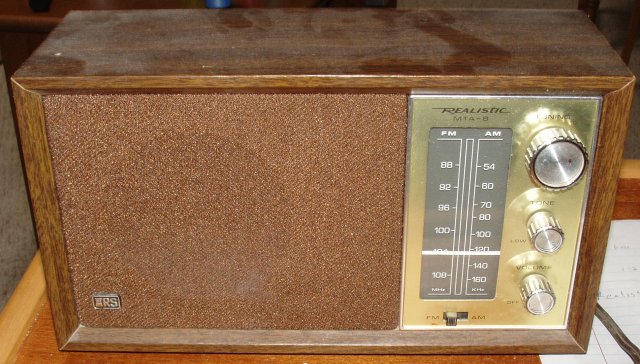
Here is one I hear over and over again. Supposedly, Ibiquity bought about 30 radios and tested them. Not a single one had a bandwidth over 3 kHz or so - leading to the conclusion that AM bandwidth can be limited to 5 kHz and nobody will care or be able to notice the difference.
I had two good reasons to be very sceptical of this claim:
OK, my word against Ibiquity, right? I have no doubt that they analyzed radios, and don't dispute they probably got a batch of narrowband receivers. But - who selected the receivers to be analyzed, and why did they ALL support the same conclusion? Hummmm - suspicious, especially in light of the fact I was finding a heck of a lot of wideband receivers - without looking especially hard.
I will introduce this receiver here, as it is pretty typical of the receivers you could buy in the 1970's. I recently inherited two of them, and they still do the job very well after three decades - after the requisite douse of cleaning spray in the potentiometers and re-alignment.

The circuit board inside has the typical pack of transistors, IF cans, and passive components. OK, if you have the PC board space, can stand realignment once in a while, and occasional failures of a random component (which usually signaled the end of life for such a radio - because few consumers sent them for repairs).
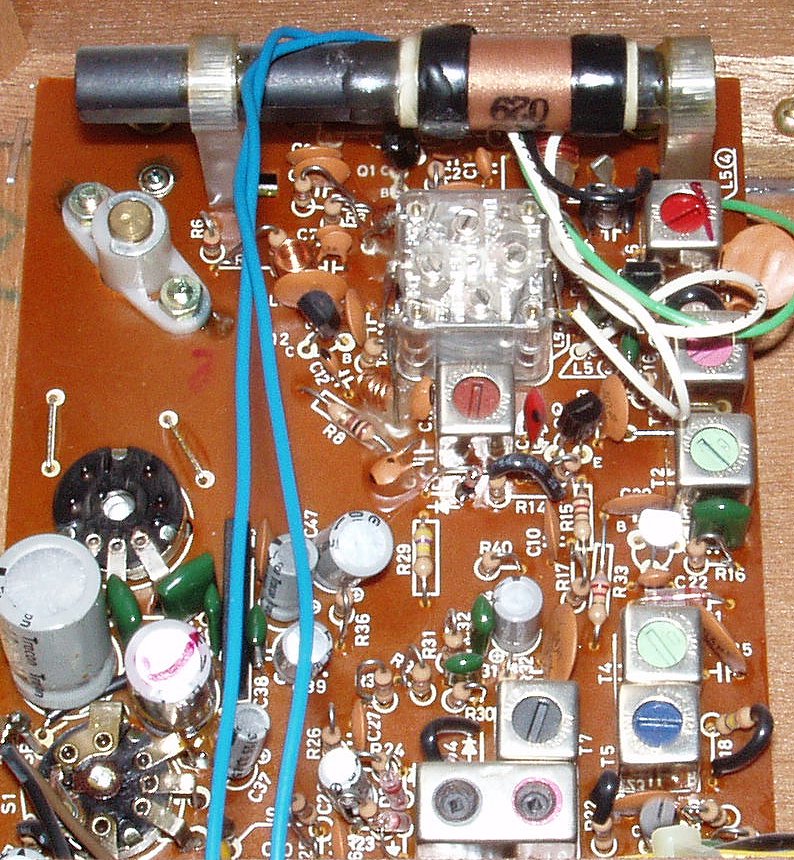
This same type of design was repeated hundreds, maybe thousands of times in radios from the time TI introduced the Regency in 1954 until very recently. Typically, the AM section would have a red core oscillator can, and three IF cans could be identified by white, black, and yellow cores. FM design varies a bit in such units, but usually consists of three IF cans, and a couple of discriminator cans located close to each other. I would not be a bit surprised if this design were still in use by a few manufacturers - but - its use is declining rapidly. This particular radio is one of the first to use an FM ceramic filter, a component which rapidly overtook the IF cans, in spite of almost suicidal cost cuts made by the IF can manufacturers. Now, the old companies that could - now make cans AND ceramic filters. The ones that couldn't support ceramic filters - OUT of business.
So - what is up with my daughter's radios that made them so wideband? The answer shocked me - and I was apalled at the shoddy receiver design I encountered. I've torn apart about 30 receivers to date, and the ones here are fairly representative of whate I am finding across the board. I've taken apart $5 radios, $100 radios. ALL are pretty much the same inside. You won't believe your eyes - how cheap things have become - but it is TRUE!!!
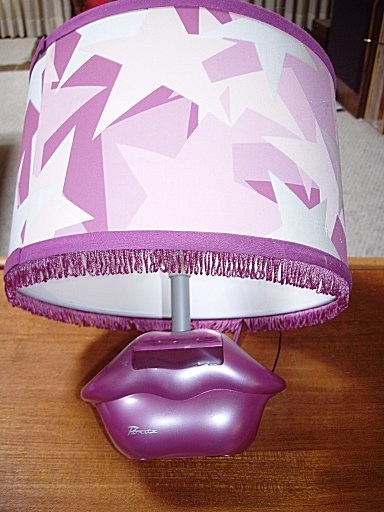
In honor of my friend Malese Jow (who was in the Bratz movie), I will analyze this radio first. It is a multi-function unit, a clock radio built into the base of a table lamp. Incidentally, this was the first unit my daughter complained about. The way it was oriented on her desk, all you would get on 620 was KSKY 660, but nulling KSKY by turning the radio so the internal ferrite bar nulled KSKY did solve the problem. It also made the clock and controls point away from the bed - NOT acceptable. So I put a better ceramic filter in it a couple of years ago.
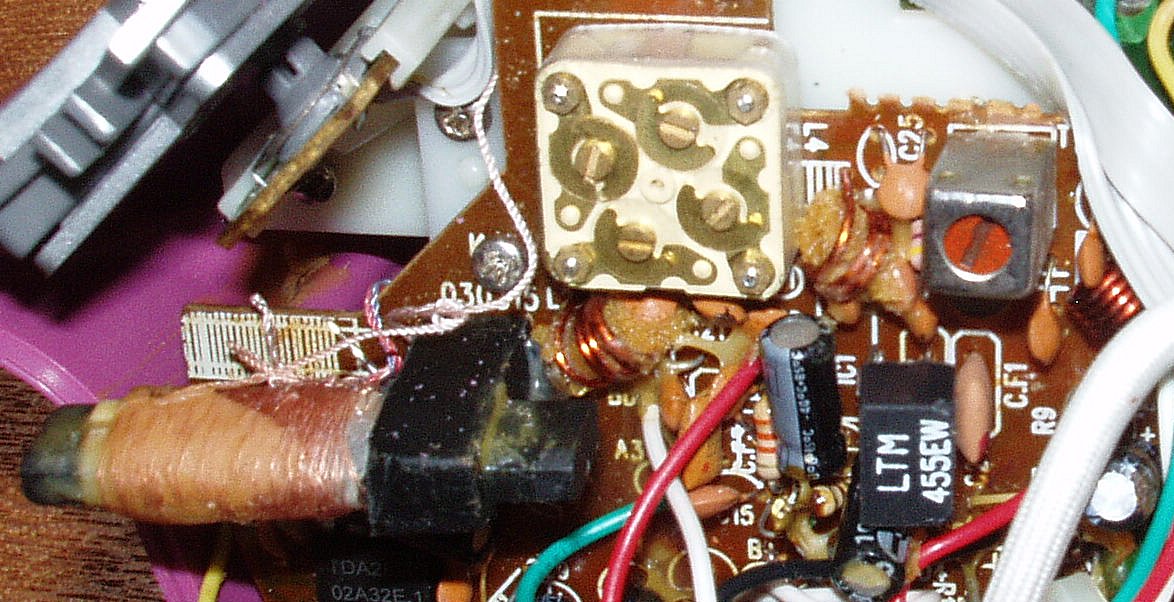
This picture shows the circuit board of the "Bratz" radio. Apparent here is a ferrite bar that is no more than an inch and a half long, the requisite tuning capacitor (2 gangs FM, 2 gangs AM), the AM Oscillator can (still red), a couple of FM coils (antenna and oscillator no doubt), and two ceramic filters - one AM and one FM. You can see I have already changed out the cheap AM ceramic filter for a much better one - the LTM 455EW out of an old wireless mouse receiver. The FM ceramic filter - 280 kHz bandwidth Murata - is to the right of it and designated CF1. Not so apparent is the FM discriminator, it is a two pin ceramic discriminator under the red wire. On the receivers I analyzed, most still use a discriminator coil, although both techniques will work with the ICs typically used in these radios. But - where is the IC? It was on the reverse side of the board:
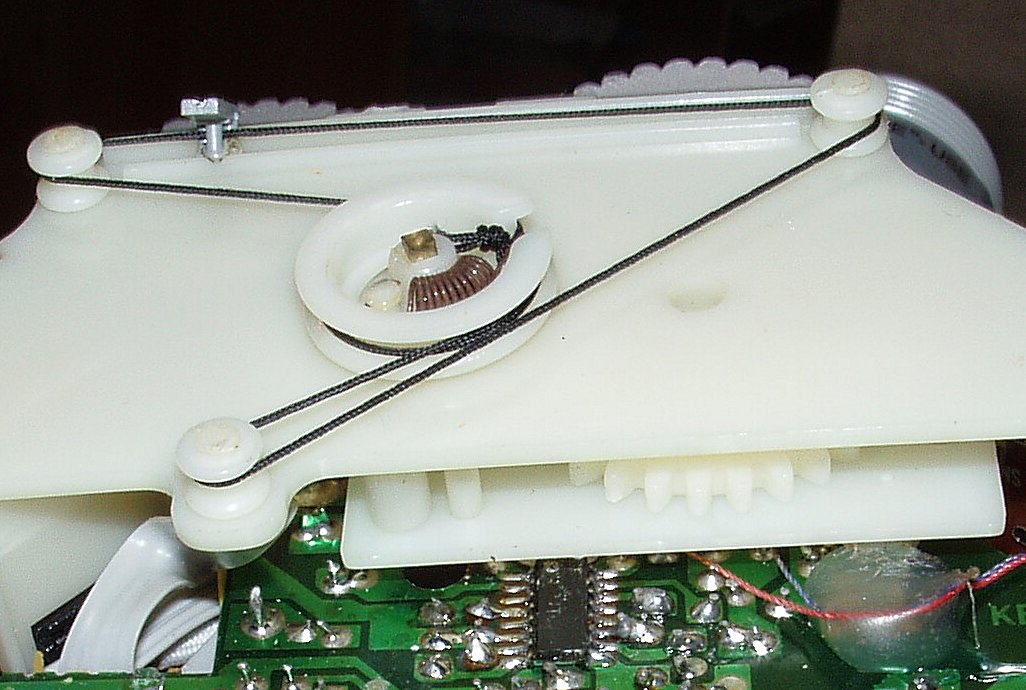
This picture also shows another problem common to these cheap radio designs - the mechanical lash of the tuning system. A slide rule dial 2 inches across is hard enough to tune in a packed urban environment, but the plastic gear poking out from underneath the dial background reveals another issue: the mechancial hysteresis of the tuning mechanism is terrible. They did things right with the spring on the end of the dial cord - but threw it all away when they used the gears without similar mechanical coupling. To make matters worse - the dial BACKWARDS - turning the tuning to the right makes the pointer go left, and vice versa. So just TRY and get this thing centered on an IBOC station - enough to eliminate the sideband hiss! Not fun.
Bottom line on the "Bratz" radio? The narrow ceramic filter got rid of KSKY, and there is a hint of 590 KLBJ in the background. The radio went from +/-40 kHz to pretty darn selective with one change.
By the way - my criticism of the Bratz radio in NO WAY reflects my opinion of Malese. The radio is marginal - but Malese and her mom and sister are top notch friends!
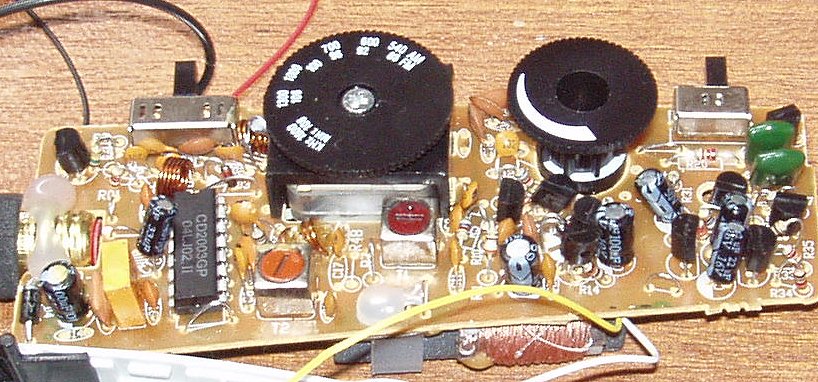
I didn't take a picture of the outside of this thing - it is just a flashlight about 6 inches long. It is probably designed to be tossed into camping gear or a car and forgotten until needed. Better hope the batteries are fresh!
Pretty much the same thing as the "Bratz" radio. Here, I got a good number off the IC. Application diagram is below that pretty much confirmed what I already knew from looking at the parts. You can see the ferrite bar under the board, again about an inch and a half. To the left of the IC, there is a yellow ceramic filter for AM, and a 280 kHz ceramic filter for FM. This one was definitely 80 kHz wide on the AM bandwidth. Again, AM oscillater coil, FM oscillater and antenna coils, this one used a brown FM discriminator coil. Here is the application diagram for the CD2003GP:

No surprises here, except that the ground connection of the ceramic filters is actually connected to VCC! This does make it easy, however, to find radios designed with the CD2003 - even if they hide the IC part number. The Ultronic designers omitted the bandpass filter on the FM antenna, and used a coil instead of ceramic discriminator on pin 10 for quadrature.
Mechanically, I actually prefer tuning this unit to the "Bratz" radio - I got a round dial directly coupled to the tuning shaft - at least there is no hysteresis and it stays tuned where I left it.
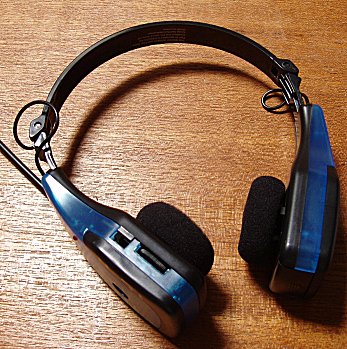
My late father was on dialysis, and the center would occasionally give premiums away to patients. Most of which ended up in my daughter's Christmas stocking - as he had little use for them.
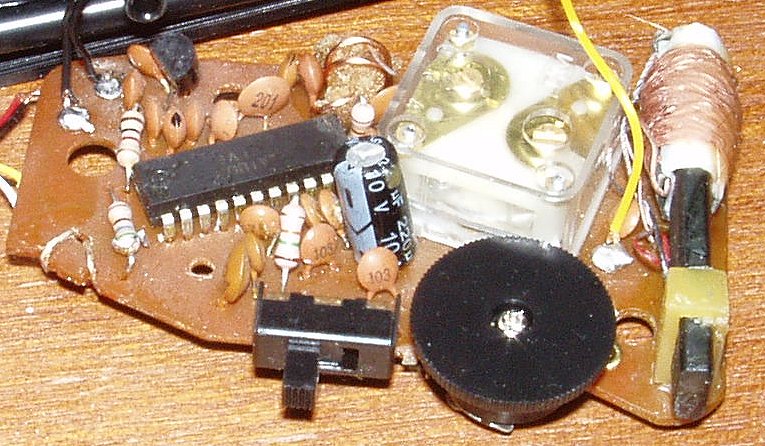
This radio was a real education in the lenths people will go to - to save money. I was only able to get a partial part number off the IC, but I got enough to know the manufacturer was Sanyo. The strange thing is - this is probably a premium part designed for much better receivers! It has enough pins to be a stereo radio chip, but the radio is mono. ALL of this company's IC's have provisions for ceramic filters - note that there are NONE - not a single ceramic filter AM or FM!!! The connections are bypassed by capacitors, which makes the IF amplifier in the chip essentially a wideband RF amplifier. Also a shock - ONE gang AM and ONE gang FM!!!
This threw me for a loop, and then I looked at the data sheets for some of these IC's and realized how they pulled this off. AM is a tuned RF radio. All of the selectivity is being accomplished by the Q of the ferrite - they route that directly to the IF amplifier and you have a glorified crystal radio.
FM fared little better - there is NO FM antenna coil. The antenna is left broadband , all of the selectivity is accomplished by the oscillator coil. At least they allow the IC to convert to an IF frequency, but bypassing the ceramic filter makes the FM tuner less than a superhet design as well. I have NO idea how they accomplished FM detection.
This one actually impressed me - the cleverness of the designers is impressive in getting the cost down. It is actually capable of receiving the strongest of the local signals in my area, some of the towers are 40 miles away on FM. AM also works well on strong local stations, but you can really notice the poor selectivity. Notice one transistor for audio amplification.
I started to wonder (a bit of a tangent here) just how far you could take the cost-cutting concept. A novelty item - my daughter's FM watch radio - answered my question:
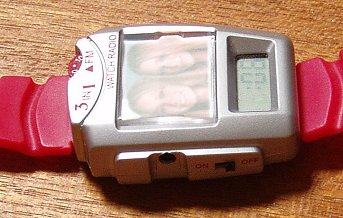
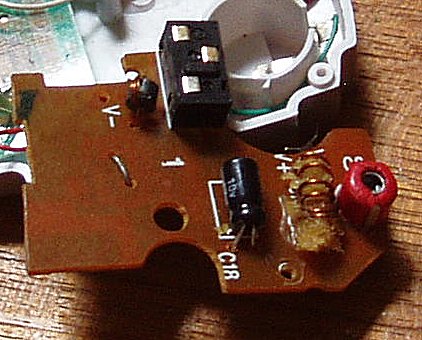
The board inside shows the answer - one IC (16 pin SOIC) on the back, one coil, one trim cap (with the tune knob engaging the adjustment) for the RF. Of course, the dial legend is almost useless with only three frequencies, and 20 degrees of mechanical lash makes it hard to get on a station. You know what? This little marvel does a great job on stations 30 to 40 miles away! Amazing --- but no AM. Back on topic:
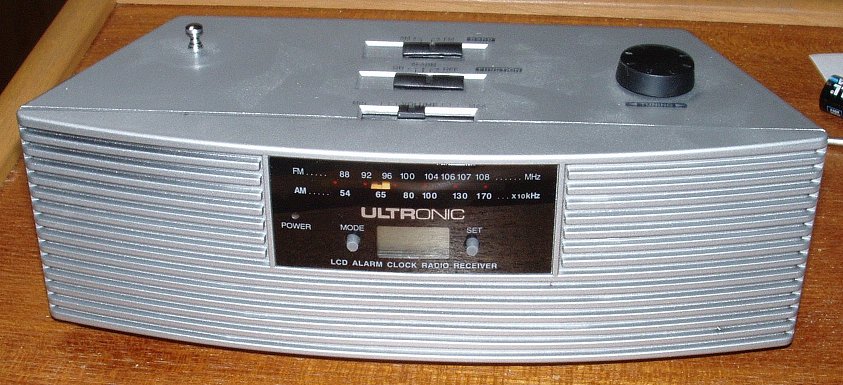
My father was a subscriber to Time Magazine, which frequently sent out premiums. As I mentioned before - these items ended up in my daughters hands. This little gem of a receiver is amazing for what is inside - an AM/FM stereo clock radio with some real station pulling power. The classic rock rim shot FM 60 to 70 miles away comes right in, as well as some out of market AMs. Not a radio for a serious DX'er, but it does the job locally and then some. But - inside:
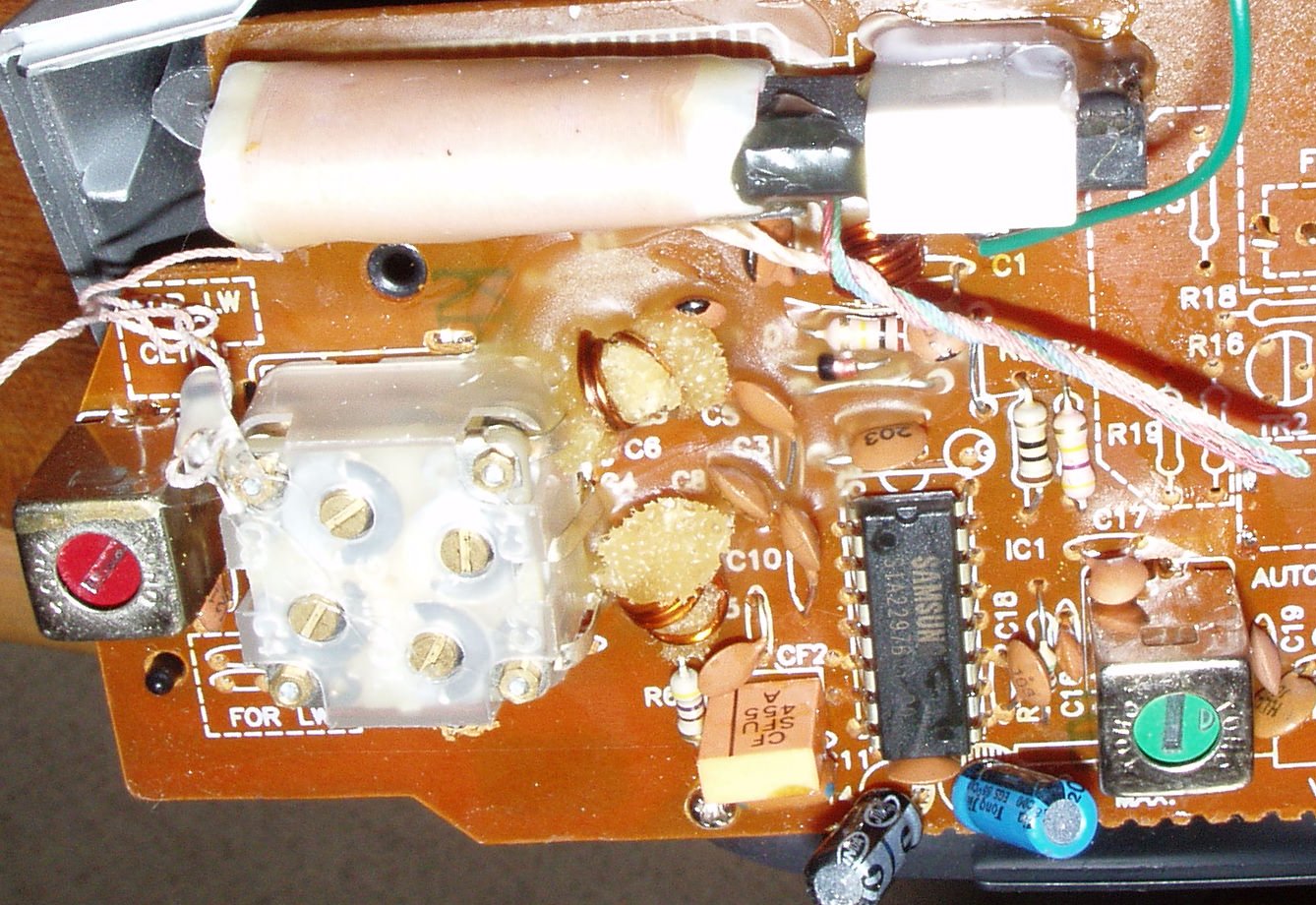
Here we go again, AM ferrite antenna (about 2 1/2 inches this time), AM oscillator can (STILL red), one FM ceramic filter, one AM ceramic filter, here they use a can for FM quad. It is a little hard to see the FM ceramic, it is under the AM. I note the blue dot - they don't bother to buy the FM ceramics that are on frequency - who cares with analog tuning? The AM ceramic filter is much better than usual - a Murata SFU455A. This radio has decent selectivity "out of the box", but with only one ceramic element, the roll off skirts are not very steep - IBOC hiss is clearly audible on all local IBOC stations. So - unless you are willing to install that premium ceramic filter I add to these designs, self jamming is going to be an issue with a single ceramic filter. Especially when the speakers are small (and therefore make pretty efficient tweeters).
Another really interesting aspect of this radio is silkscreening for longwave components. Clearly, Ultronic supplies low cost receivers world wide. I see a lot of eBay listings, but I couldn't find a web site for the corporation.
I had little problem tuning the Ultronic - it has an unusually good tuning mechanism for this class of radio:
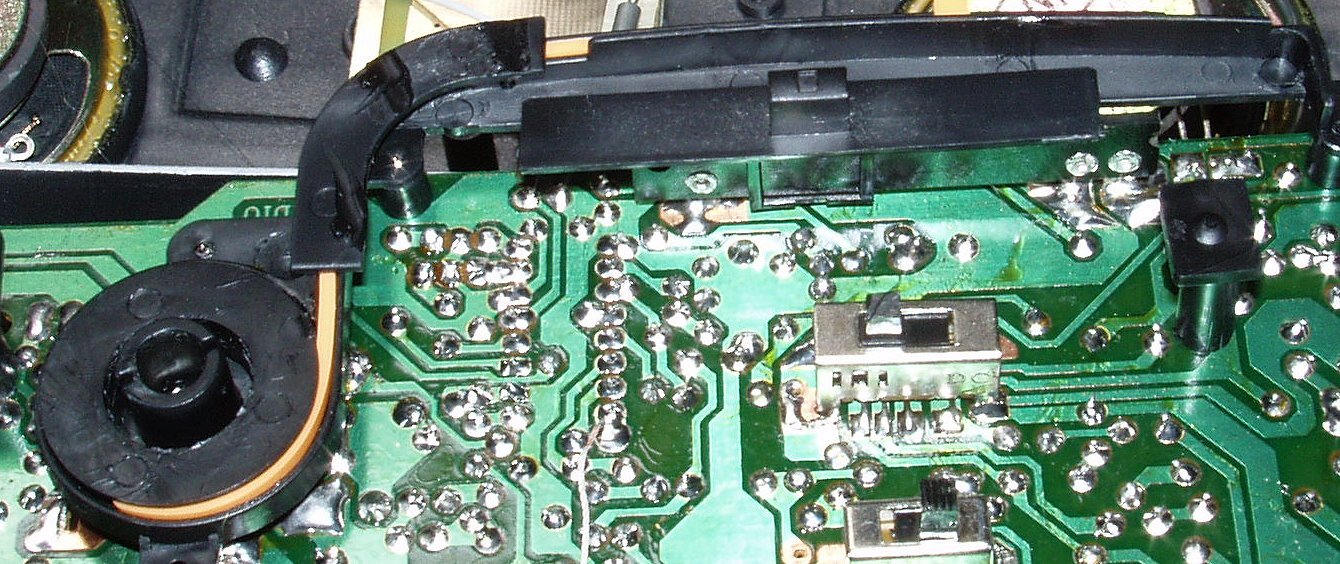
Not a true slide rule dial with step down operation, but a direct connection to the tuning capacitor is brought out through a tan flexible plastic to couple directly to the dial pointer. Very slick trick! All the advantages of direct coupling to the tuning capacitor AND a slide rule indicator.
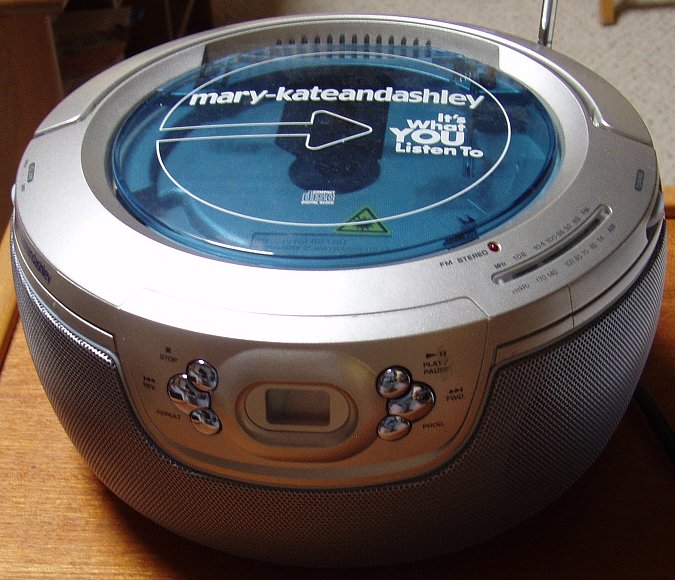
My daughter has outgrown "Mary Kate and Ashley" for the most part. But this boom box continues to give her good service several years later. I found that merchandise sold by the twins is of good quality - the clothing was most durable. Apparently, the merchandising company has been told to sell good quality, and this piece of electronics was no exception. Looking inside:
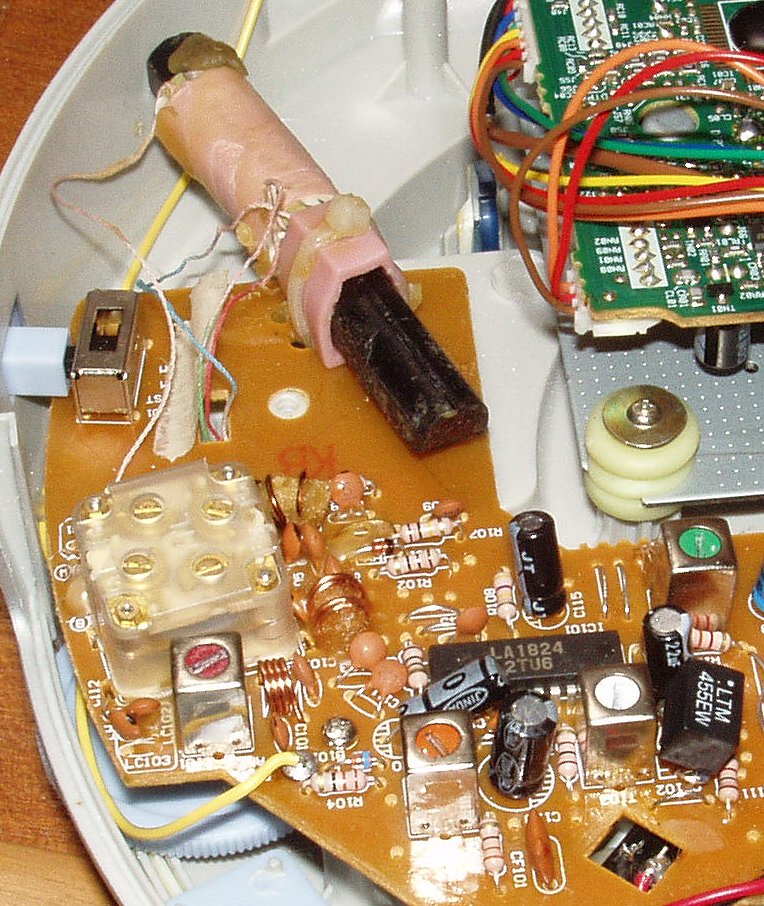
Exactly the same story with minor variations. (Note - I had been inside and made modifications. Premium LTM455EW ceramic filter and a better AM ferrite bar). Red AM Oscillator can, One FM ceramic filter (I put in a 150 kHz ceramic for a selectivity boost), FM antenna and oscillator coils, here they actually put in a ONE AM IF can which most of the IC manufacturers specify on their data sheets, but are seldom used by the designers.
I have nothing but admiration for these IC manufacturers. While I was inside this radio putting in the better ceramics - I temporarily installed an 8 inch ferrite bar antenna. To my amazement - the sensitivity of this little rig was almost as good as a GE Superadio! This is one radio I am grabbing when my daughter is through with it. The IC is LA1824:
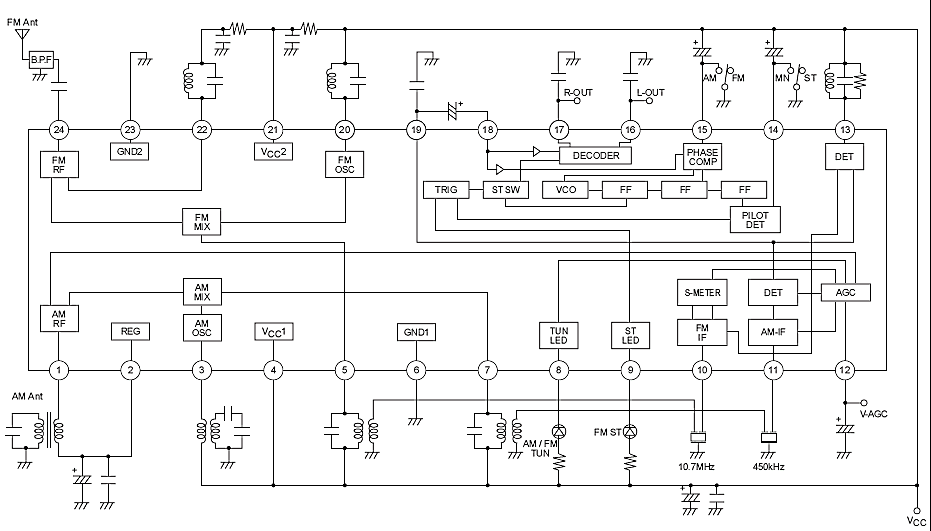
And you can see the recommendation for the one AM IF can coupling to the one AM ceramic filter. Before modification - AM IBOC self jamming was clearly audible - the original AM ceramic was the SFU455A. After improvement, there was considerably less self jamming noise.
A new twist on the cost cutting angle - NO tuning indicator at all! I have been encountering a new type of radio, usually just FM but they can include AM, that has NO tuning dial at all. It has a "scan" button that ramps a tuning voltage and stops on strong signals. There is usually also a "reset" button that puts the tune voltage down to the low end of the dial again. These radios are often coupled with LED flashlights as a keychain or oblong shape with a company logo prominently displayed as advertising.
Here is a look inside a couple of these radios:
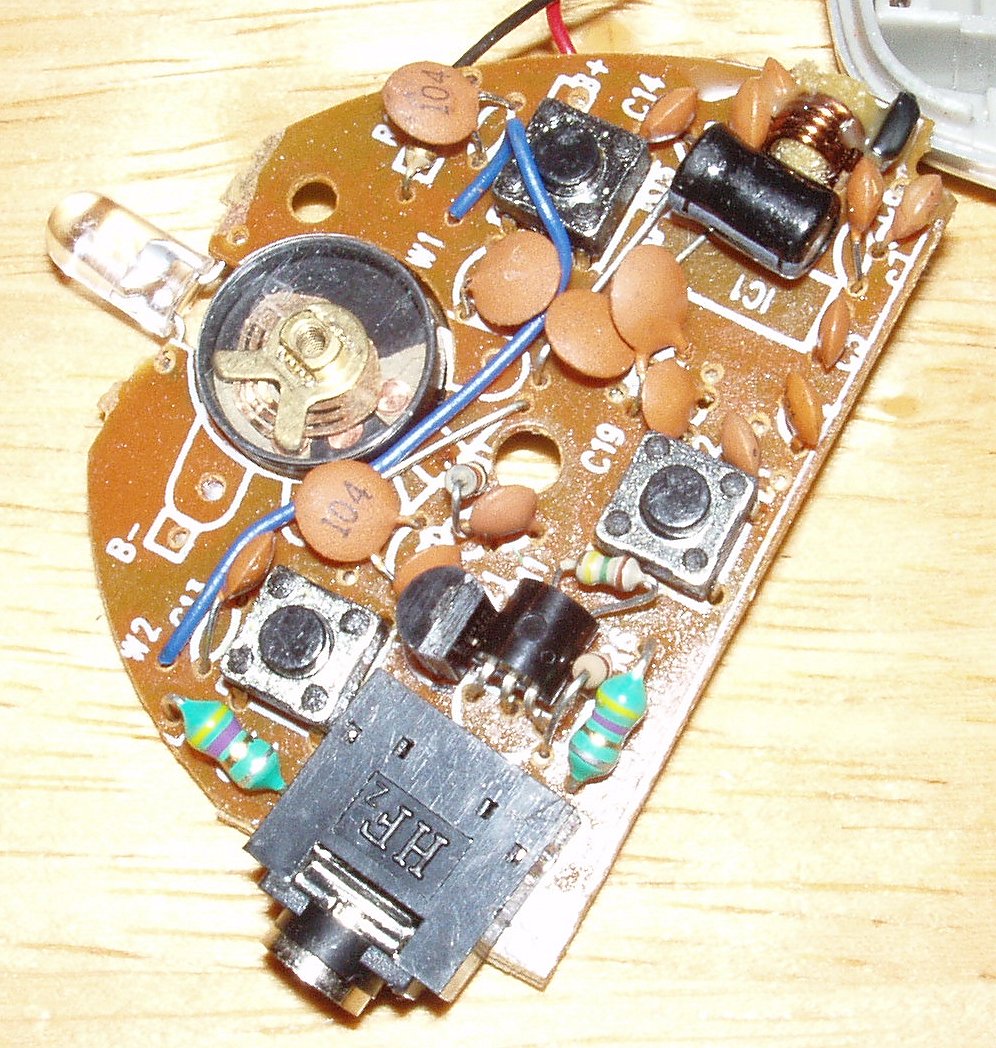
And the other side:
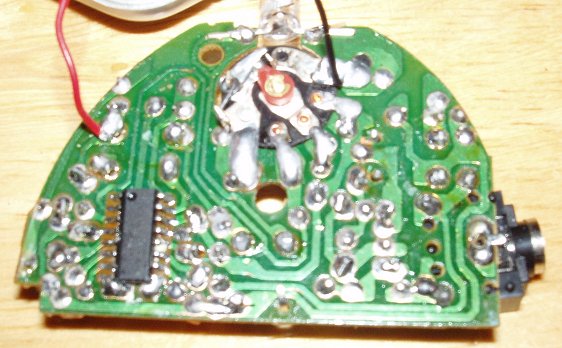
Another one - made to look like an iPod on the exterior:
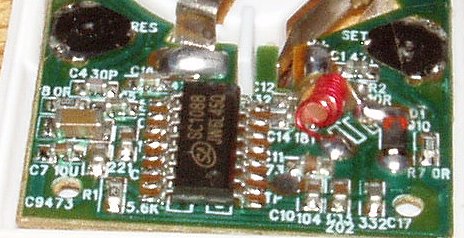
The things to note - no ceramic filters. Was this another cost reduction, or something else? It turns out to be something else:

The SC1088 is a chip commonly used. Look at the application diagram - the IF ceramic is not even shown, but presumably could be inserted instead of the 3.9nF capacitor between pins 8 and 9. But only if they still used 10.7 MHz as the IF frequency - there is no guarantee they have even done that!
Cost savings with this design - NO ceramic filter, NO external quadrature detector NO tuning capacitor - it has been replaced by a varactor diode V101. And - NO costs associated with an indicator for the station, the radio just ramps tuning voltage until a strong signal, where it stops. WOW! Just how far can they take THIS trend??? That answer in just a minute.
For now, I need to mention a serious problem with this design: it will stop on IBOC sidebands - FM (or AM) before it stops on a station. In other words, the user is going to hear LOUD annoying static when the radio locks on a lower sideband, have to push "run" or "scan" again to lock onto the analog signal, then if they want another station, they first get the upper sideband of the IBOC station. NOT a pleasant band scan - and I tried it. That is what happens. If the next station is also IBOC, you get TWO lound static channels in a row. BLEAH! I predict IBOC will completely kill this type of radio - consumers will hate them because of the loud sidebands.
--- and it's NOT HD!!! This is what all radios will eventually be made of: Single chips!!!
Yep - that is right. The closest you will get to RF design if you are designing a consumer radio will be picking which single chip radio IC is the lowest cost and best fit for your product. I don't work for Silabs. They are just the first company to market. Others will follow. And the crystal? If USB interfaces are any indication, that crystal will also be designed out and all you will have is antenna in, controller lines, and L R audio out. And a version with the controller on the chip and direct display output will be right on its heels from a dozen different manufacturers. Instant gratification, low cost, high reliablity, performance MAY or MAY NOT be good. But probably good because they want to have one product that fits all from 99 cent AM FM stereo headphone models to $500 home entertainment systems.
OK, back to myth #1, AM radios are all narrowband. At this point, I could put a couple of dozen more receiver teardowns on this page and bore you with the same designs used over and over again by a dozen manufacturers. But a single AM ceramic filter - even a relatively good one like an SFU455A, simple doesn't have the roll-off to eliminate IBOC artifacts from 10 to 15 kHz. They come right through, loud and clear. Add to that poor mechanical design of tuning systems, and it is difficult to tune on frequency, which allows the 5 to 10 kHz sidebands to come through as amplitude modulated. Bottom line - on the AM radios sold based on these IC's I've documented, you are in for one very unpleasant AM radio listening experience when you tune to an IBOC station. At this point, I would have to call the myth that most AM radios are narrowband:
Until next time - Shredderman - out.